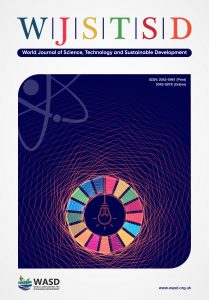Estimation of Market Potential and Willingness to Pay for Forestry Insurance: Evidence from Tree Growers in the Ashanti Region of Ghana, Dr. Nicholas Mensah, Ernest Amrago, Jacqueline Twintoh, Anthony Donkor and Samuel Anang
 Dr. Nicholas Oppong Mensah
Dr. Nicholas Oppong Mensah
School of Agriculture and Technology, Department of Agricultural Economics, Agribusiness, and Extension
University of Energy and Natural Resources (UENR), Sunyani
Ghana
Email: nicholas.mensah@uner.edu.gh
Ernest Christlieb Amrago
School of Agriculture and Technology, Department of Agricultural Economics, Agribusiness, and Extension
University of Energy and Natural Resources (UENR), Sunyani
Ghana
Email: ernestchristliebamrago@yahoo.com
Jacqueline Joyce Twintoh
Council for Scientific and Industrial Research
Forestry Research Institute of Ghana (FORIG), Kumasi
Ghana
Email: jvtwintoh@gmail.com
Anthony Donkor
School of Agriculture and Technology, Department of Agricultural Economics, Agribusiness, and Extension
University of Energy and Natural Resources (UENR), Sunyani
Ghana
Email: anthony.donkor@uner.edu.gh
Samuel Afotey Anang
School of Agriculture and Technology, Department of Agricultural Economics, Agribusiness, and Extension
University of Energy and Natural Resources (UENR), Sunyani
Ghana
Email: samuel.anang@uenr.edu.gh
DOI: 10.47556/J.WJSTSD.19.1.2022.1
Purpose: In this study, we estimate the market potential and willingness to pay (WTP) for forestry insurance in the Ashanti Region of Ghana. The study examines the factors influencing the expenditure on premiums for forestry insurance across varying quantiles of expenditure and mean WTP premium for forest insurance products.
Design/methodology/approach: A total of one hundred and seventy (170) tree growers/foresters were sampled for the study. The quantile regression was employed to analyse the factors influencing the expenditure on premiums for forestry insurance and the double-bound contingent valuation method for the mean WTP.
Findings: The market potential was high for Cedrela and low for Emeri. Varying factors affect the expenditure on premiums for forestry insurance at different quantiles. The mean WTP for Teak, Cedrela, African Mahogany, Emeri and Oframo was respectively Ghc 7.989 (US$ 1.38), Ghc 112.747 (US$ 19.44), Ghc 58.069 (US$ 10.00), Ghc 29.092 (US$ 5.000) and Ghc 28.292 (US$ 4.88).
Originality/value: The study adds to the body of literature by estimating the market potential and willingness to pay for forestry insurance, particularly in Ghana.
Keywords: Market Potential; Forestry Insurance; Quantile Regression; Double-Bound; Ghana.
Citation: Mensah, N.O., Amrago, E.C., Twintoh, J.J., Donkor, A. and Anang, S.A. (2022): Estimation of Market Potential and Willingness to Pay for Forestry Insurance: Evidence from Tree Growers in the Ashanti Region of Ghana. World Journal of Science, Technology and Sustainable Development (WJSTSD), Vol. 19, No. 1, pp. 1–15.

